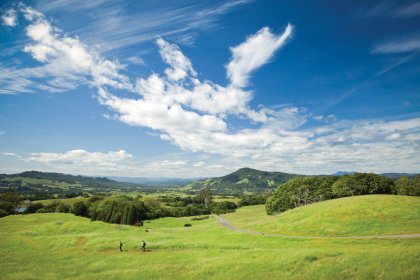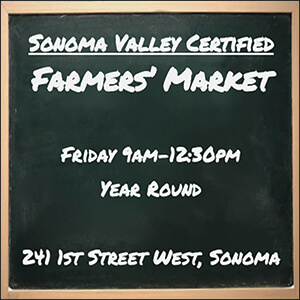
Sonoma Mountain and the urbanization of wildlands

By Will Shonbrun —
“I ride over my beautiful ranch. Between my legs is a beautiful horse. The air is wine. The grapes on a score of rolling hills are red with autumn flame. Across Sonoma Mountain wisps of sea fog are stealing. The afternoon sun smolders in the drowsy sky. I have everything to make me glad I am alive. I am filled with dreams and mysteries. Jack London, John Barleycorn (1913).
In 1905, Jack London, acclaimed author, world traveler, foreign correspondent, farmer, socialist, humanist and courageous enjoyer of life found the place that spoke to him on the side of Sonoma Mountain in what was known as, The Valley of the Moon. He knew at first sight it was where he would set his roots and live his days with his beloved wife and companion, Charmian, farming and writing and thinking about the things that interested him.
He had known many places, from Europe to Japan to East Asia and the South Pacific, but it was the rural and still wild Sonoma Mountain country that told him it was to be his place, this low mountain range where from time to time an enormous moon practically sat in your lap while you looked up into its face that seemed no further than somewhere just down the road, no higher than a tall redwood and to which he would always return. Maybe it was a touch of lunacy, or some pulls from a whiskey jug, maybe both, but somehow London knew this valley and this mountain were where he was supposed to be.
London didn’t buy what he and Charmian named “Beauty Ranch” to amass fortune, but to work the land and farm the soil using practices we now call sustainable agriculture by using nature’s innate elements for replenishing and replicating the natural growing cycles. His approach to stewarding the land was built on respect for its vital needs and the bounty it gifted. In this he mirrored and honored the native peoples’ relationship with the natural world in the thousands of years they’d lived there.
That’s all about to change.
Brief backstory
Most readers, especially residents of Sonoma Valley, know the backstory of the demise of the Sonoma Developmental Center (SDC), officially closed in 2018. The period from that closing to the sale of the State-owned SDC land to a chosen developer is a many-faceted story that has been extensively covered by local press from practically every angle. It won’t be repeated here. The wrap-up comes down to this: The buyer intends to build about 1000 houses, a 120- room hotel/ resort, and provide the land for all the businesses that will be needed to serve these new thousands of residents’ and visitors’ needs on the approximately 200- acres on what’s referred to as “the campus”.
In short, what this plan adds up to is the creation of a new town in the midst of a rural and wildlife region in the heart of Sonoma Valley. There are no existing public facilities on this section of mountain land: no schools, no medical services, no community or government centers and just one road in and out. All the needs and necessities of three to five thousand people inhabiting this new town will have to be built and operated.
Urban sprawl on steroids
The State of California in its wisdom and in conjunction with Sonoma County are abandoning all its years of prior land use decisions regarding urban infill, and urban growth boundaries to prevent urban sprawl into greenbelts and open space buffers between urban centers. In so doing, both state and county are acting in disregard of and contrary to all their stated and pledged climate environmental actions to address global warming and all that portends. Which begs the question, why is public land, paid for with public money able to be privatized and commodified without public consent?
For the last 6 to 7 years, buoyed by persistent state and county encouragement of having an equal voice in the disposition of the land, thousands of Sonoma Valley people have diligently participated in the process of choosing how and by whom the land should be used, only to find out these were empty promises. One can conclude, rightly or not, that being gamed in this way was to divert, curtail or pre-emptively shut down any concerted public resistance to simply selling the land to the highest bidder, which is exactly what happened.
But at its core, the growth and development are being driven by a state imposed mandatory housing dictate to address what has been labeled a “housing crisis.” But the putative housing crisis is not one for market rate housing, but for affordable housing. However, the state-selected developer, Grupe/Rogal, has made it clear it does not intend to build more than ten to fifteen percent affordable” housing. I will add to this, ‘if any’, as builders have found legal ways around required affordable housing provisions with a wink/nod gimmick referred to as the “builder’s remedy.”
To make matters worse, in addition to the proposed housing and commercial development at SDC is the sale of six-to-seven hundred acres on the neighboring Hannah Boys Center Sonoma Mountain property for, as you might have guessed, housing. How many people and their daily vehicle miles traveled that this additional development on rural land adds up to, can only be guessed.
And while we’re indulging questions … why has it rarely, if ever, been asked, how many trees is it reckoned will be cut down to oblige the building of 1000 houses and innumerable commercial businesses, and in particular woodland oaks? Why woodland oaks? A recent Press Democrat news article addresses that question imparting, “Nothing … supports greater wildlife diversity than oak woodlands, which hosts thousands of species … county planners said,” regarding the necessity for saving trees, (Rules fail to take root, Press Democrat, Dec. 4, 2023). However, now it seems the value of trees, other than as a commodity, is being conveniently ignored by our county building planners.
This is an environmental issue
In this writer’s view, the disposition of the former SDC land is not a housing issue, or a sell the land and make it profitable for state and county issue. This is a matter about preserving and protecting an ancient, biologically diverse, self-sustaining ecosystem of intrinsic value for the enjoyment and knowledge it bestows for all to experience. By ‘experience’ I mean to visit and explore its flora and fauna, tread gently and respectfully and leave no trace of having been there. This 750- acre ecosystem, with a wildlife corridor running through it, cannot remain viable in conjunction with the kind of urban development that is planned.
Look what has been done to California’s and the Earth’s environment in our drive for growth and development to suit human expansion at any cost, and without consideration of actual sustainability of land, water, air and atmosphere in and on which we all reside and depend. The signature old growth California redwoods have been decimated to the point of extinction. Our land, coastal and inland waters, are polluted with toxic chemical fertilizers and other agricultural tools, and our forests clear-cut for the ever-expanding human population. Land and sea species have been hunted to near extinction, rain forests obliterated and desertification rank as among our greatest environmental challenges.
We humans do not and should not live everywhere. Just as we need to honor and preserve the remaining wilderness areas, we must recognize the importance of rural landscapes and green buffer zones so that urban regions have access and connection to the natural world and what it teaches us. We have much to learn and time is surely running out.
If we build a new town in the middle of Sonoma Valley on mountain land that runs contiguous with the rural wildlands and its wildlife, it presages the ultimate destruction of the latter. Such towns start small but will not stay so, as that’s not the way growth and development works. We know this pattern to be true as we’ve seen how this has played out here in Sonoma County and elsewhere in our state.

Back to Jack
Hill Ranch (Jack’s first purchase in Sonoma County):
“There are 130 acres in the place, and they are 130 acres of the most beautiful, primitive land to be found in California. There are great redwoods on it, some of them thousands of years old. . . in fact, the redwoods are as fine and magnificent as any to be found anywhere outside the tourists groves. Also there are great firs, tanbark oaks, maples, live-oaks, white-oaks, black-oaks, madrone and manzanita galore. There are canyons, several streams of water, many springs … I have been riding all over these hills, looking for just such a place, and I must say that I have never seen anything like it.” – 1905
Jack London knew what he was talking about, and he knew when he saw it that it was a treasure to protect and preserve. He left it as a legacy for us and all others who would understand its innate value. If we let this go on the auction block for a quick profit for government functionaries and the business merchants that influence them, we will have sold another of nature’s gifts for a handful of silver.
9 thoughts on “Sonoma Mountain and the urbanization of wildlands”
Comments are closed.







Thank you Will. This truth is painful and brings sadness to many of us. We have to stand up, we have to keep trying. Last night I attended the State of the Valley, put on by the chamber of commerce. Two speakers representing the city of Sonoma spoke about how money, TOT and sales tax are number one and that this fact will never change. So on we go, destroying our valley. They both noted that annexing the Springs would be a good idea. Of course as more TOT and sales tax can come from the development of this area too. Mike Thompson spoke first and stated the climate change is the number one issue in our world. But, we here in the Sonoma Valley will just keep building more, more, more in search of dollars.
What a beautiful and important essay. Thank you, Will.
Is there anyway to stop it at this point? Could public outright make a difference at this stage in the game?
What occurred over 120 years ago has little relevance to matters of today with exception of an attempt to reach the reader emotionally. The true violation here are our elected local and state representatives that only represent their own pockets and thats where articles needs to be focused to get voters fired up and take action and make people accountable for their actions. The governor on down should be fired for their personal financial special interests. We must vote for preservation and not allow special interest
Buy and develop our dwindling resources.
Sadly we have one supervisor to represent us a the county level. The other supervisory districts also had a vote on this. So you are right, we need to vote in new people who are not beholding to big business. They had sham meetings to supposedly hear from the community. I attended most of them and we were not heard. As we go into a election year, maybe we should grill the candidates for district 1 supervisor and call them out if they do not support reversing this deal with the state. The county was supposed to have a say in the plan. Again though I am sure the rest of the county is happy to dump this mess here to meet its housing element goals.
Sadly, until we change the laws of how any elected official is gets campaign funding, it’s not going to change.
Will,
There is also a new resort and I believe 168 units of low income housing scheduled to go in on Verano, near McDonalds where the old Paul’s used to be. They just received the financing and are going to charge ahead. Imagine what that will do to the already clogged intersection of Hwy 12 and Verano!
Your words ressurect my personal experiences and memories of riding horseback from the Arnold Dr., Preysbeterian Conference ground’s,through SDC’s western, Fern Lake, region and ending at Jack London State Park.I’m forever thankful for both the opportunities to be a member of the Eldridge community and experience the majestic beauty. Im saddened beyond compare yet remain hopeful for a miracle
We who have loved this land and adored our privilege being here need to remember and envisage how earlier locals saw our arrivals. I’ve heard it said more than once. They loved that we came with money. Their humble homes and lands began to look like successful investments or opportunities unfathomable in years previous. The bigger players in wine and other farming saw a future that became as we’ve seen it. Holding to higher ecological and aesthetic standards interferes with the relentless flows of commerce as Will writes. Our land begs for peaceful and appropriate commerce. Sadly it doesn’t appear the officials are willing to listen effectively.